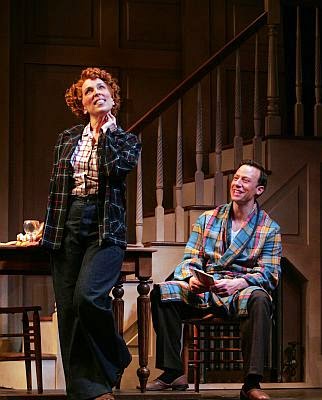Looking Back at 2014
Photo by Carol Rosegg
By Geary Danihy
Critics are lucky…and unlucky. We get to see some marvelous theater,
but we also have to sit through productions that, if we weren’t charged with
writing a review, we’d escape and go in search of the nearest watering hole.
Critics are (although may be arguable), also human, and
although we are in the theater to evaluate the production, we are also there as
members of the audience, just plain folk wishing to be entertained. With that
in mind, and in no special order, here are some of the shows that, for one reason
or another, entertained me.
I pull out the theater programs from the past season and
right on top is Westport Country Playhouse’s “Sing for your Shakespeare.” Yes,
there was a mismatch in casting, but the evening was, on the whole, a delight
and Stephen DeRosa’s take on the Bard was worth the price of admission. It was
joyful and tuneful, and I left the theater humming.
Rebekah Brockman and Tom Pecinka in Arcadia.
Photo by Joan Marcus
Next on the pile is the program for Yale Rep’s “Arcadia ,” Tom Stoppard’s
cerebral investigation of the past impinging on the present. It was a totally
engaging production with a stellar cast – one of those evenings that demands
you seek a quiet bistro after the performance to argue about the ideas the
playwright offers up in a delicious pastiche of historical drama framed by modern
misalliance.
Center: Steven Mooney (Barfee); L-R: Natalie Sannes (Olive), Maya
Naff (Marcy), Scott Scaffidi (Chip), Kevin Barlowski (Leaf), and
Hillary Ekwall (Schwarzy). Photo by Rich Wagner
Immediately beneath the “Arcadia ” program are three programs from
Playhouse on Park. This theater, now in its sixth season, continues to improve
as it never fails to entertain. Many theatergoers in southwest Connecticut are used to making the drive up to Hartford to attend
performances at Hartford Stage and TheaterWorks, but they should add this
compact venue to their list. The three programs are for, in order, “The 25th
Annual Putnam County Spelling Bee,” “Angels in America , Part One” and “Altar Boyz.”
The “Spelling Bee” production was the best ensemble work I’ve seen all year, “Angels”
was gripping and “Altar Boyz” a delight from start to finish.
Enough can’t be said for “Endurance,” a production of Split
Knuckle Theatre that was boarded at Long Wharf Theatre. This troupe of four
actors created an absolutely mesmerizing evening of theater that, with just
basic props, evoked two completely different yet totally realized worlds:
modern American business and an Antarctic expedition. I didn’t move in my seat
from curtain to curtain and had to shove my jaw shut several times.
I flip several programs, and there is “Hamlet,” produced up
at Hartford Stage. Under the direction of Darko Tresnjak, who is on a creative
roll that one can only hope will not stop, this production was gripping,
visceral theater from start to finish. I came away once again understanding
what Aristotle meant when he posited tragedy can generate catharsis.
The cast of "Avenue Q" Photo by Richard Pettibone
Good things also happened in lower-profile venues.
TheatreWorks New Milford’s production of “Avenue Q” was a sheer delight. I’d
seen this show several times before, but this production just seemed to bubble
with enthusiasm and wit – again, a wonderful ensemble of actors. The same can
be said of the four actors in “God of Carnage,” produced by the Darien Arts
Center Stage – what delightful venom, spit and suburban sniping.
Penny Balfour, David Margulies, Tom RiisFarrell, Dina Shihabi.
Photo by T. Charles Erickson
Last, but certainly not least (only because the programs are
on the bottom of the pile) are Long Wharf’s production of Steve Martin’s “Picasso
at the Lapin Agile,” Goodspeed’s “Fiddler on the Roof,” MTC Mainstage’s “The
World Goes ‘Round” and Westport Country Playhouse’s “Intimate Apparel.” Long Wharf
All in all, lucky critics who got to see these and other
productions. Someone recently asked me, “Don’t you get a bit jaded seeing all
these plays and musicals?” No, I don’t. That’s like asking, don’t you get bored
eating every day? Yes, sometimes the meals are consumed merely to sustain life,
but there are other times when the meal is something more, something that makes
you feel rather special for having been served such a delightful repast, when
you sense the soul of the chef in the offering. Such is the case with going to
the theater on a regular basis. Yes, sometimes you come away with indigestion,
but there are other times when you end the evening not only satisfied but entranced…and
happy that you have been able to feast at the table of consummate creativity.
One “Fiddler” or “Hamlet” or “Arcadia ”
makes you forget all the stale or half-baked productions, and you hunger for
more.






























